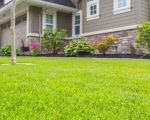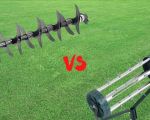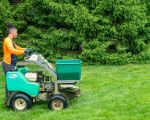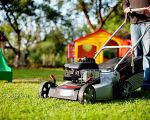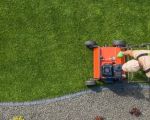- - Understanding the Importance of a Lawn Care Schedule
- - Seasonal Lawn Care: A Month-by-Month Guide
- - Key Lawn Maintenance Tasks for Each Season
- - Lawn Care Tips for a Green and Healthy Lawn
- - How to Make the Most of Your Lawn Care Schedule
Understanding the Importance of a Lawn Care Schedule
Maintaining a beautiful, lush green lawn year-round requires more than just watering and occasional mowing. A well-planned lawn care schedule is essential for promoting healthy grass growth, preventing common lawn issues, and keeping your yard looking great in every season. By organizing your lawn maintenance tasks throughout the year, you can ensure that your grass gets the right care at the right time, leading to a vibrant and resilient lawn.
A well-structured lawn care schedule takes into account various seasonal needs such as fertilization, aeration, mowing, and pest control. By following a tailored approach to lawn care, you can prevent weeds, reduce the risk of diseases, and make your lawn more resistant to droughts and other challenges. At [Lawn Care Services], we provide expert advice and products to help you create the perfect lawn care schedule for your needs.
Seasonal Lawn Care: A Month-by-Month Guide
To ensure your lawn thrives throughout the year, it's important to adjust your care routine with each season. Different tasks are required during various months, depending on the temperature, moisture levels, and grass growth cycles. Below is a month-by-month guide to help you build an effective lawn care schedule:
Spring Lawn Care (March-May)
Spring is the time for rejuvenation, as the weather warms up and grass begins to grow actively again. During this period, focus on:
- Fertilization: Apply a slow-release fertilizer to promote healthy growth.
- Aeration: Aerate your lawn to improve soil drainage and root health.
- Seeding: Overseed bare spots to fill in any thin patches.
- Weed Control: Apply pre-emergent herbicide to prevent weeds from taking root.
Summer Lawn Care (June-August)
Summer's hot weather can stress your lawn, making it crucial to maintain proper hydration and protection. Focus on:
- Watering: Water deeply and infrequently to encourage deep root growth.
- Mowing: Keep the lawn at a higher mowing height to shade the soil and retain moisture.
- Pest Control: Monitor for pests such as grubs and apply treatment as needed.
- Weed Management: Continue to manage weeds, especially during dry spells.
Fall Lawn Care (September-November)
Fall is one of the most important times for lawn care, as the grass is preparing for winter dormancy. Focus on:
- Fertilization: Apply a fall fertilizer to strengthen the roots for winter.
- Leaf Removal: Regularly remove fallen leaves to prevent them from suffocating the grass.
- Overseeding: Fall is an ideal time to overseed for thicker grass growth in the spring.
- Aeration: Aerate the lawn again to relieve compaction and enhance root growth.
Winter Lawn Care (December-February)
Although growth slows in winter, your lawn still needs some attention. Focus on:
- Protection: Avoid walking on the lawn during frost to prevent damage to the grass.
- Monitoring: Keep an eye out for any snow mold or winter diseases.
- Planning: Use the winter months to plan next season’s lawn care tasks and purchase necessary supplies.
Key Lawn Maintenance Tasks for Each Season
Each season brings specific lawn care tasks that are essential for maintaining a year-round green lawn. Here are some of the key tasks for each season:
Spring Maintenance
Spring is the time to kickstart your lawn care routine. After winter, grass can become compacted and may need aeration to ensure that air, water, and nutrients reach the roots. Fertilizing early helps your lawn develop strong roots, and overseeding helps fill in any gaps caused by winter damage.
Summer Maintenance
In the summer, watering becomes critical. Avoid shallow watering, as it encourages weak root systems. Instead, water deeply to encourage deep-root growth. Mowing height is also important—keeping your grass slightly longer helps shade the soil, reducing water evaporation. During hot weather, try to water early in the morning or late in the evening to prevent evaporation during the hottest part of the day.
Fall Maintenance
Fall is when your lawn prepares for dormancy. Aeration and fertilization are key to ensuring that your lawn stays healthy through the winter months. Raking leaves promptly is also essential to prevent them from smothering the grass and creating mold issues.
Winter Maintenance
Winter maintenance focuses mainly on protecting your lawn. Avoid walking on frozen grass and snow-covered lawns, as it can damage the grass. Regularly check for any winter diseases, and plan your spring care strategy during this downtime.
Lawn Care Tips for a Green and Healthy Lawn
To keep your lawn looking green and healthy year-round, consider these additional lawn care tips:
- Soil Health: Regular soil testing can help identify nutrient deficiencies and ensure that your lawn gets the right type of fertilizer.
- Proper Mowing: Avoid cutting more than one-third of the grass height at once. Cutting too short can stress the grass.
- Weed Control: Stay on top of weed management throughout the year to prevent competition with your grass for nutrients and water.
- Fertilization Schedule: Be mindful of the timing and type of fertilizer you use for each season. A slow-release fertilizer is ideal for promoting steady growth.
How to Make the Most of Your Lawn Care Schedule
To get the best results from your lawn care schedule, it’s important to stay consistent and proactive. Keep track of your lawn’s progress, monitor for any changes in the weather, and adjust your schedule as needed. Investing in quality products and expert services, like those offered by [Lawn Care Services], can help you maintain a vibrant and healthy lawn all year long.
By following these tips and adhering to a tailored lawn care schedule, you'll be able to enjoy a lush, green lawn no matter the season. With the right care and attention, your lawn will not only look great but also provide a comfortable space for outdoor activities throughout the year.

